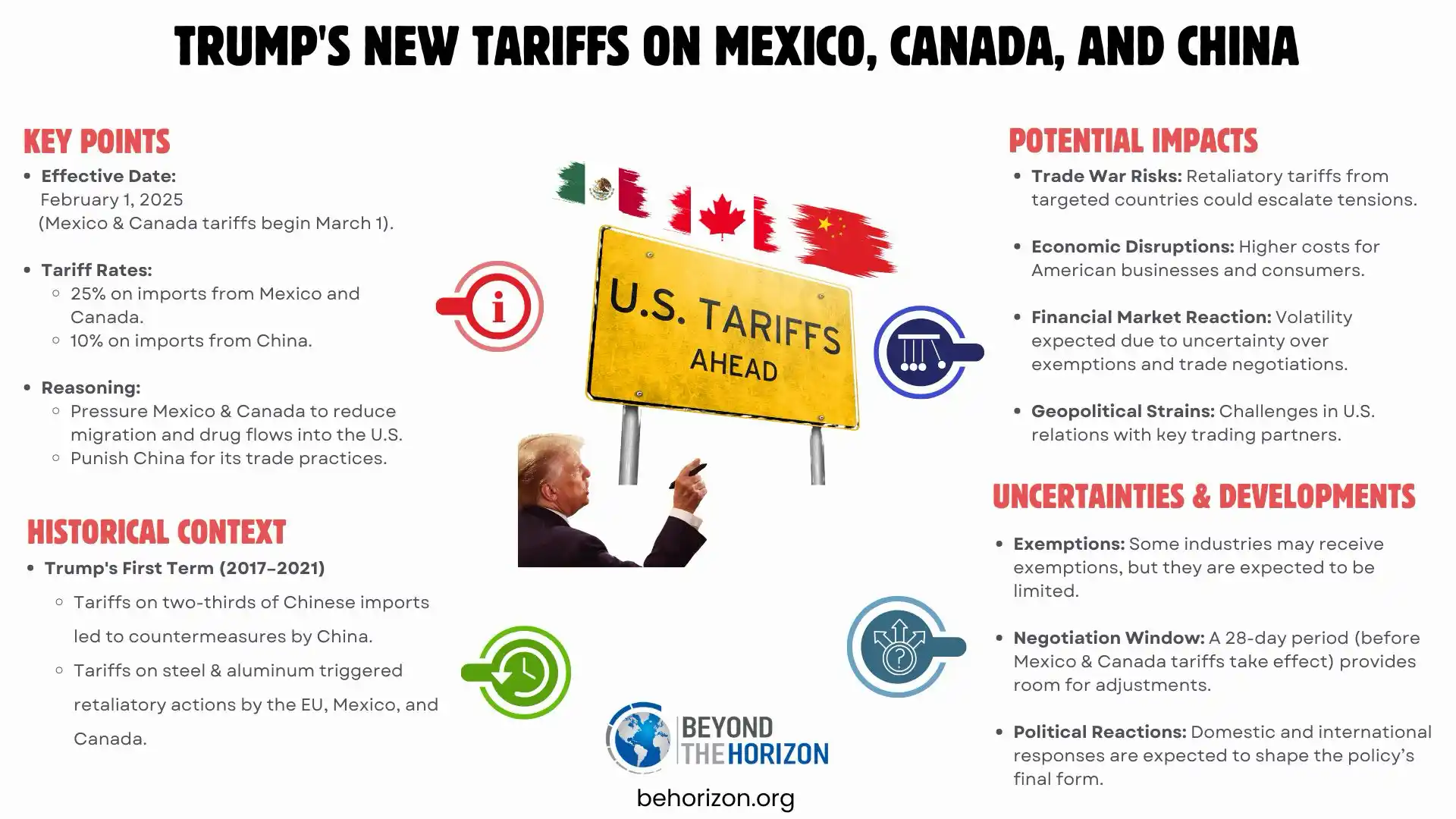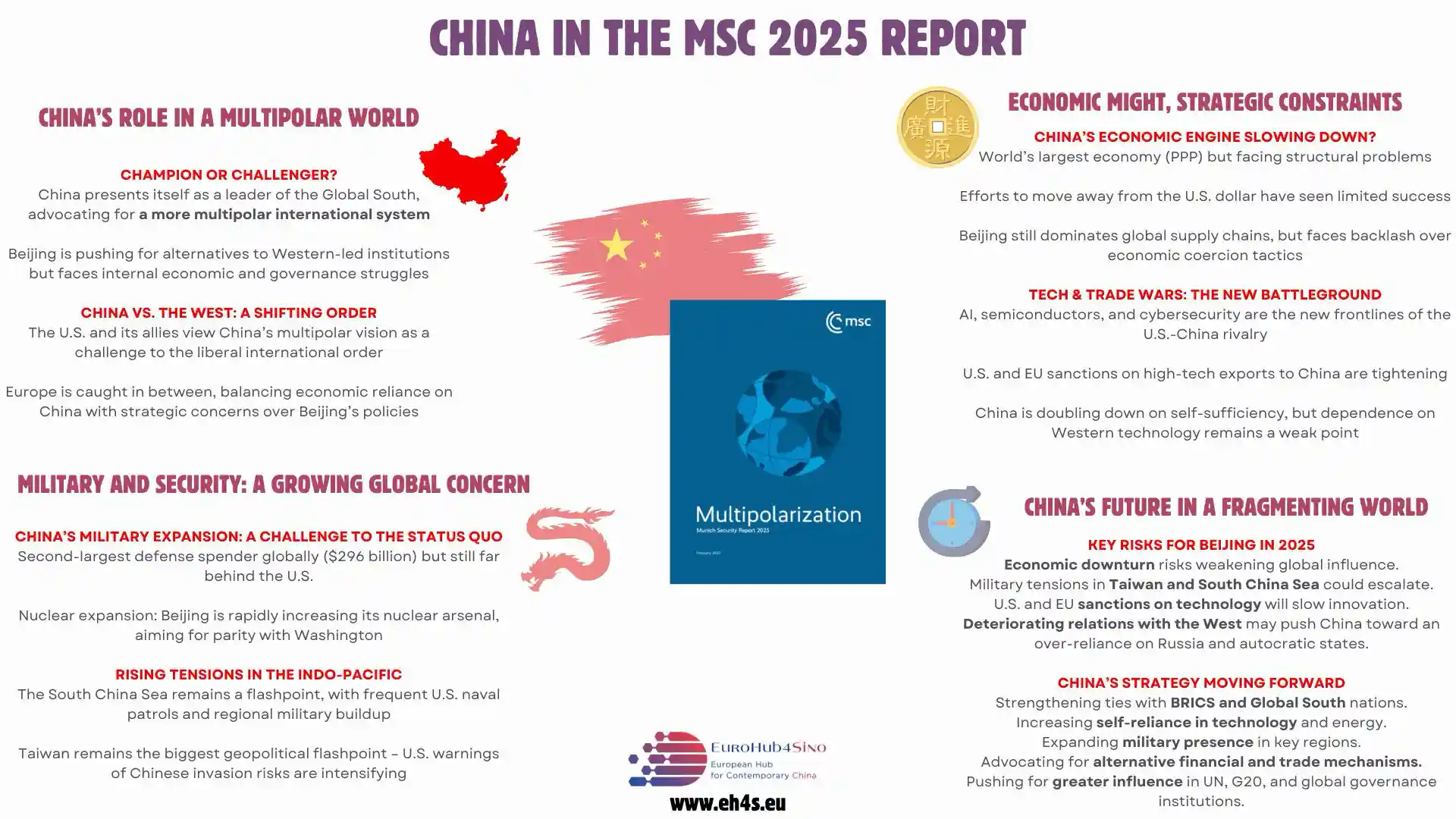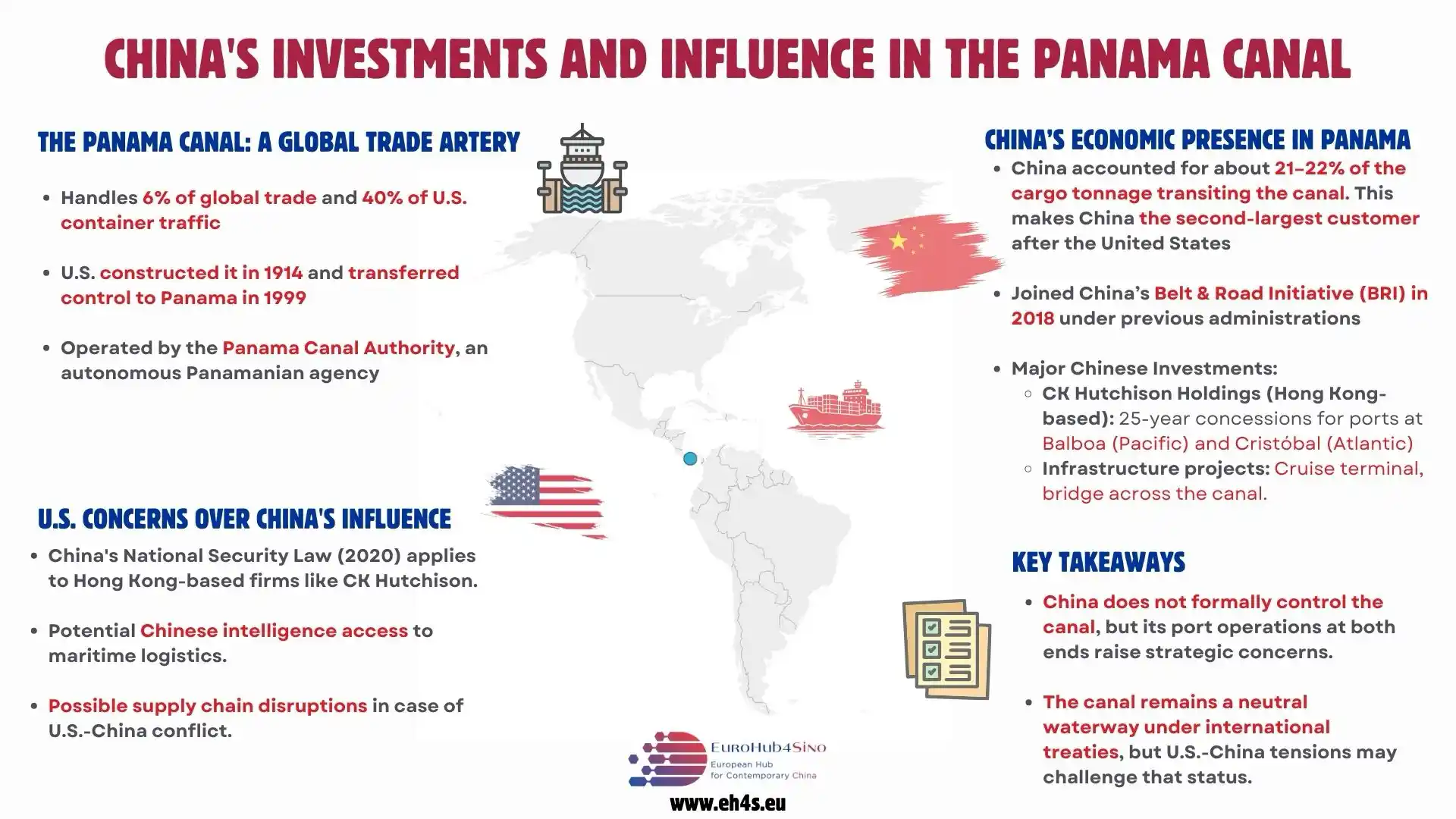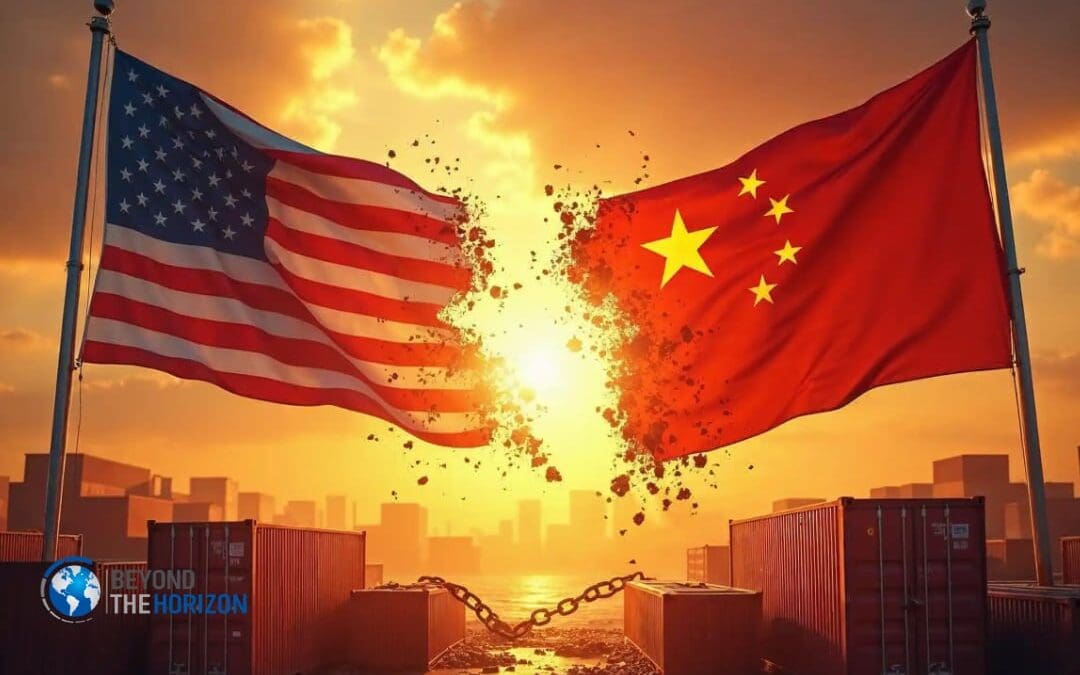Key Takeaways:
- Strategic Motives:
Trump’s tariffs, aimed at reducing reliance on China and boosting domestic industry, mark a return to protectionism with broader economic and political implications. While the administration frames tariffs as a way to counter China’s industrial policies and income inequality, they risk deepening economic tensions and triggering prolonged retaliation.
- Domestic Economic Impact:
Tariffs drive up consumer prices, disproportionately affecting lower-income households while offering uncertain benefits for job creation. U.S. industries dependent on Chinese imports face rising costs, and retaliatory measures from China threaten key export sectors like agriculture, energy, and manufacturing.
- Global Trade & Geopolitical Ramifications:
The trade war disrupts global supply chains, forcing businesses to seek alternatives to Chinese manufacturing, though at high costs. China’s push for self-sufficiency in critical industries could weaken U.S. leverage, while international trade norms erode as more countries prioritize economic security over free trade.
- Long-Term Risks & the Need for a Balanced Approach:
Economic decoupling between the U.S. and China risks creating fragmented global trade blocs, reducing efficiency and competitiveness. A more sustainable approach should combine innovation investment, workforce development, and strengthened trade partnerships rather than relying solely on tariffs.
- Final Thought:
The trade war is not just an economic dispute but a defining moment in global economic history with lasting consequences. Policymakers must balance national interests with global stability to avoid long-term economic fragmentation and uncertainty.
Introduction
The U.S.-China trade conflict has escalated under President Donald Trump’s second term, with a new wave of tariffs threatening to trigger a full-scale trade war. Trump has imposed sweeping duties, including a 10% tariff on all Chinese imports and 25% levies on steel and aluminum, signaling a return to aggressive protectionism. Unlike his first administration, where tariffs targeted China’s alleged unfair trade practices, the current approach is intertwined with broader economic concerns, including domestic manufacturing revival and income inequality.
Supporters argue that tariffs will reduce reliance on Chinese imports, bolster industrial competitiveness, and create jobs. However, critics warn they will drive up consumer prices, disrupt supply chains, and intensify economic tensions. The international response has been swift— China has retaliated with countermeasures, targeting key U.S. exports and restricting access to critical raw materials, while Canada, Mexico, and the EU prepare their own trade defenses.
This analysis examines the strategic motivations behind Trump’s tariff policies, their economic impact, and their geopolitical consequences. It assesses whether the administration’s approach can effectively rebalance trade and reduce inequality or if it risks deepening economic uncertainty and global instability.
Strategic Rationale Behind the Trade War
The renewed U.S.-China trade war reflects a broader strategic rivalry shaped by economic nationalism, geopolitical maneuvering, and domestic politics. Unlike previous disputes focused on trade deficits and unfair Chinese practices, Trump’s second-term tariffs are framed as tools for both economic rebalancing and reducing domestic income inequality. The administration argues that tariffs can counter China’s state-led industrial policies while revitalizing U.S. manufacturing and protecting American workers.
Economic Nationalism and Industrial Protectionism
For decades, U.S. policymakers have viewed China’s economic model—characterized by subsidies, intellectual property theft, and market restrictions—as distorting global trade. While past administrations sought to curb these practices, Trump’s policies go further, tying protectionism to a broader industrial strategy. The goal is to reduce reliance on foreign supply chains, reshore critical industries, and create higher-paying jobs. This shift responds to growing concerns that globalization has disproportionately benefited multinational corporations and skilled professionals while eroding manufacturing jobs and wage growth for less-educated workers.
Tariffs as a Response to Income Inequality
The administration also presents tariffs as a means to address economic disparities, arguing that decades of offshoring and cheap imports have widened wage gaps. By discouraging reliance on Chinese goods, the policy aims to boost domestic production and job creation in struggling industries. However, critics warn that tariffs function as a consumer tax, raising prices without necessarily ensuring employment gains. Industries reliant on imported materials—such as auto and electronics manufacturing—may face rising costs, potentially offsetting any job benefits.
Balancing Trade Retaliation and Economic Security
China has responded with countermeasures, including restrictions on key exports like rare earth minerals and regulatory hurdles for U.S. firms. This retaliation raises concerns that an extended trade war could accelerate China’s push for self-sufficiency, further disrupting global supply chains and diminishing U.S. economic leverage. While some policymakers believe economic pressure will force China to reform, others fear prolonged conflict will deepen global economic fragmentation.
Domestic Economic Implications
The renewed U.S.-China trade war carries significant consequences for the American economy, impacting consumer prices, labor markets, supply chains, and long-term growth. While the administration frames tariffs as a corrective tool to rebalance trade and address wage disparities, the economic effects are complex, creating winners and losers across different sectors.
Consumer Costs and the Burden on Lower-Income Households
Tariffs function as an indirect tax, increasing prices on imported goods, particularly essentials like electronics and food. Lower-income households, which allocate a larger share of income to consumer goods, bear the heaviest burden. Previous tariff rounds raised annual household costs by $800–$1,200, and new levies are expected to exacerbate inflationary pressures. This undercuts the administration’s argument that tariffs will reduce income inequality, as rising costs may offset potential wage gains in protected industries.
Manufacturing and Labor Market Disruptions
Tariffs are intended to bolster domestic manufacturing, yet their track record in job creation remains mixed. While some industries may benefit from reduced foreign competition, others reliant on Chinese components face higher production costs, reduced profit margins, and potential layoffs. Historical precedent shows that firms often respond by relocating to alternative low-cost hubs like Vietnam or Mexico rather than reshoring jobs to the U.S. Additionally, automation continues to limit large-scale industrial job growth, further complicating the effectiveness of tariffs as a labor policy.
Retaliatory tariffs also pose risks, particularly for export-driven sectors. China has targeted U.S. agriculture, energy, and automotive industries, leading to financial losses and market uncertainty for American businesses. Farmers, for example, have already faced declining soybean exports due to previous trade restrictions, reinforcing concerns over prolonged instability.
Supply Chain Adjustments and Industrial Competitiveness
Global supply chains are undergoing restructuring as companies seek alternatives to Chinese manufacturing. While this may enhance resilience over time, the transition is costly and disruptive. Businesses face logistical hurdles, increased production expenses, and difficulties replicating China’s manufacturing efficiency. Countries like Vietnam, India, and Mexico have absorbed some of this shift, but adaptation remains slow and uneven.
Policy unpredictability further discourages investment, as businesses hesitate to make long-term commitments amid uncertain trade conditions. This climate of instability threatens economic growth, particularly for industries requiring strategic capital expenditures and supply chain security.
Long-Term Economic Growth and Productivity Concerns
Beyond immediate disruptions, the trade war risks reducing U.S. economic efficiency and global competitiveness. Protectionist policies can lead to resource misallocation, stifling innovation and technological advancement in key sectors like semiconductors and artificial intelligence, which depend on international collaboration.
A prolonged economic decoupling from China may also accelerate global trade fragmentation, increasing costs and reducing efficiency. As the two largest economies drift apart, regionalized trade blocs may emerge, slowing investment, productivity, and job creation while weakening global economic growth.
International and Geopolitical Ramifications
The renewed U.S.-China trade war extends beyond tariffs, shaping broader strategic competition between the world’s two largest economies. While framed as an economic dispute, its geopolitical consequences include retaliation risks, global supply chain disruptions, and the erosion of trade norms. The conflict threatens to accelerate economic decoupling and reshape the global trading system, introducing long-term uncertainty.
Retaliation and the Risk of Escalation
China has countered U.S. tariffs with a mix of trade restrictions, regulatory crackdowns, and export controls, targeting key American industries:
- Tariffs on U.S. Exports: Duties on agricultural products, energy, and manufactured goods have hurt American farmers and industrial producers.
- Regulatory Barriers: Increased scrutiny on U.S. firms operating in China has complicated market access for tech, finance, and manufacturing companies.
- Export Controls: Restrictions on rare earth minerals, essential for high-tech industries, serve as leverage while advancing China’s self-sufficiency initiatives.
This tit-for-tat strategy raises the risk of escalation, prolonging economic instability with ripple effects beyond the U.S. and China.
The Weaponization of Trade and the Erosion of Global Trade Norms
The trade war reflects a growing trend of economic tools being used as instruments of geopolitical influence. Both the U.S. and China are bypassing multilateral institutions like the WTO in favor of unilateral actions, undermining the rules-based trade system. The shift toward national security-driven trade policies encourages economic fragmentation, with nations prioritizing self-sufficiency over open markets, potentially leading to the rise of competing trade blocs.
Global Supply Chain Vulnerabilities and Realignments
The conflict is accelerating shifts in global supply chains as companies seek alternatives to Chinese manufacturing hubs. Vietnam, India, and Mexico have emerged as beneficiaries, but replicating China’s efficiency remains a challenge. Reshoring efforts also face obstacles, including higher costs and infrastructure gaps. Meanwhile, China is advancing its Made in China 2025 initiative to achieve technological self-sufficiency, which could diminish U.S. leverage in key industries over time.
The Trade War’s Impact on Third-Party Economies
Beyond the U.S. and China, the trade war affects other economies:
- Manufacturing Diversification: Countries like Vietnam and India attract production shifts, though at the cost of supply chain disruptions.
- Commodity Market Disruptions: U.S. farmers face lost market share as China sources agricultural and energy imports elsewhere.
- Regional Trade Agreements: Uncertainty has increased interest in multilateral frameworks like the CPTPP and RCEP, reinforcing regional trade ties.
Geopolitical Consequences: The Risk of Economic Decoupling
The trade war underscores a broader push toward selective decoupling, particularly in strategic sectors like semiconductors, telecommunications, and defense. While full-scale decoupling remains impractical due to deep market integration, the emergence of competing economic spheres—centered around the U.S. and its allies versus China and its partners—could reshape global trade, investment flows, and diplomatic alignments.
Conclusion: The Uncertain Path Ahead
The renewed U.S.-China trade war reflects a broader contest over economic power, industrial policy, and geopolitical influence. While tariffs are framed as a corrective measure to rebalance trade and address domestic disparities, their broader impact is far more complex. The conflict has already triggered price hikes, supply chain disruptions, and retaliatory actions, raising concerns over whether the costs outweigh the intended benefits.
The Risk of Escalation and Global Economic Fragmentation
Beyond economic consequences, the trade war is fueling geopolitical tensions and reshaping global supply chains. As businesses shift production away from China, emerging economies face both opportunities and risks. Meanwhile, the erosion of global trade norms and the WTO’s diminished role raise concerns about the future of the rules-based trading system. If unilateral trade actions persist, the likelihood of economic fragmentation and competing trade blocs will grow.
Assessing the Long-Term Economic Consequences
The sustained impact of the trade war depends on how policymakers navigate the evolving landscape. If tariffs remain in place, the U.S. risks prolonged inflation, weakened competitiveness, and job losses in export-dependent industries. China faces its own challenges, as economic conflict could slow growth and accelerate its push for self-sufficiency. As both nations move toward economic independence, the risk of technological bifurcation and long-term trade realignment increases.
The Need for a More Balanced Approach
Given the risks, tariffs alone are unlikely to resolve structural economic challenges. A more sustainable approach should include:
- Investing in Innovation: Strengthening R&D in critical sectors like semiconductors and AI to maintain technological leadership.
- Workforce Development: Equipping workers with skills to compete in a shifting economy rather than relying on low-wage manufacturing jobs.
- Strengthening Trade Partnerships: Engaging allies in trade agreements to counterbalance China’s influence while preserving market access.
- Enhancing Supply Chain Resilience: Encouraging diversification without excessive protectionism to ensure economic security.
Final Thoughts: The High Stakes of Trade Policy Decisions
The U.S.-China trade war is more than just a dispute over tariffs—it is a defining moment in global economic history, with far-reaching implications for trade, geopolitics, and the future of economic policy. While tariffs can serve as a powerful negotiating tool, their long-term effectiveness remains uncertain, and the potential for unintended consequences is significant.
Moving forward, policymakers must recognize that trade policy alone cannot resolve the structural challenges facing the U.S. economy. Addressing issues such as income inequality, industrial competitiveness, and supply chain resilience will require a more nuanced approach that goes beyond protectionist measures.
As the global economy continues to evolve, the ability of the U.S. and China to navigate their economic rivalry in a way that minimizes disruption and fosters long-term stability will be critical. Whether the trade war leads to a more balanced and competitive global economy or a prolonged period of economic uncertainty will depend on the decisions made in the coming years. The stakes could not be higher, and the path forward remains uncertain.
Related Infographics




